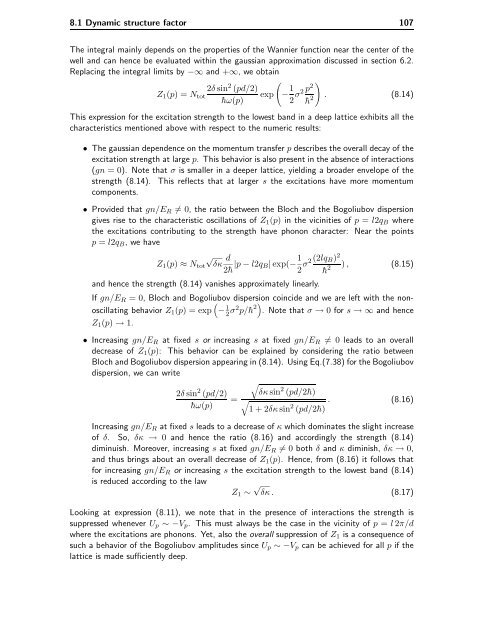Bose-Einstein Condensates in Rotating Traps and Optical ... - BEC
Bose-Einstein Condensates in Rotating Traps and Optical ... - BEC
Bose-Einstein Condensates in Rotating Traps and Optical ... - BEC
You also want an ePaper? Increase the reach of your titles
YUMPU automatically turns print PDFs into web optimized ePapers that Google loves.
8.1 Dynamic structure factor 107<br />
The <strong>in</strong>tegral ma<strong>in</strong>ly depends on the properties of the Wannier function near the center of the<br />
well <strong>and</strong> can hence be evaluated with<strong>in</strong> the gaussian approximation discussed <strong>in</strong> section 6.2.<br />
Replac<strong>in</strong>g the <strong>in</strong>tegral limits by −∞ <strong>and</strong> +∞, weobta<strong>in</strong><br />
2δ s<strong>in</strong><br />
Z1(p) =Ntot<br />
2 (pd/2)<br />
exp<br />
¯hω(p)<br />
<br />
− 1 p2<br />
σ2<br />
2 ¯h 2<br />
<br />
. (8.14)<br />
This expression for the excitation strength to the lowest b<strong>and</strong> <strong>in</strong> a deep lattice exhibits all the<br />
characteristics mentioned above with respect to the numeric results:<br />
• The gaussian dependence on the momentum transfer p describes the overall decay of the<br />
excitation strength at large p. This behavior is also present <strong>in</strong> the absence of <strong>in</strong>teractions<br />
(gn =0). Note that σ is smaller <strong>in</strong> a deeper lattice, yield<strong>in</strong>g a broader envelope of the<br />
strength (8.14). This reflects that at larger s the excitations have more momentum<br />
components.<br />
• Provided that gn/ER = 0, the ratio between the Bloch <strong>and</strong> the Bogoliubov dispersion<br />
gives rise to the characteristic oscillations of Z1(p) <strong>in</strong> the vic<strong>in</strong>ities of p = l2qB where<br />
the excitations contribut<strong>in</strong>g to the strength have phonon character: Near the po<strong>in</strong>ts<br />
p = l2qB, wehave<br />
√ d<br />
Z1(p) ≈ Ntot δκ<br />
2¯h |p − l2qB| exp(− 1<br />
2<br />
σ2 (2lqB) 2<br />
¯h 2 ) , (8.15)<br />
<strong>and</strong> hence the strength (8.14) vanishes approximately l<strong>in</strong>early.<br />
If gn/ER =0, Bloch <strong>and</strong> Bogoliubov dispersion co<strong>in</strong>cide <strong>and</strong> we are left with the nonoscillat<strong>in</strong>g<br />
behavior Z1(p) = exp − 1<br />
2σ2p/¯h 2<br />
. Note that σ → 0 for s →∞<strong>and</strong> hence<br />
Z1(p) → 1.<br />
• Increas<strong>in</strong>g gn/ER at fixed s or <strong>in</strong>creas<strong>in</strong>g s at fixed gn/ER = 0leads to an overall<br />
decrease of Z1(p): This behavior can be expla<strong>in</strong>ed by consider<strong>in</strong>g the ratio between<br />
Bloch <strong>and</strong> Bogoliubov dispersion appear<strong>in</strong>g <strong>in</strong> (8.14). Us<strong>in</strong>g Eq.(7.38) for the Bogoliubov<br />
dispersion, we can write<br />
2δ s<strong>in</strong> 2 (pd/2)<br />
¯hω(p)<br />
=<br />
<br />
δκ s<strong>in</strong>2 (pd/2¯h)<br />
<br />
1+2δκ s<strong>in</strong>2 . (8.16)<br />
(pd/2¯h)<br />
Increas<strong>in</strong>g gn/ER at fixed s leads to a decrease of κ which dom<strong>in</strong>ates the slight <strong>in</strong>crease<br />
of δ. So, δκ → 0 <strong>and</strong> hence the ratio (8.16) <strong>and</strong> accord<strong>in</strong>gly the strength (8.14)<br />
dim<strong>in</strong>uish. Moreover, <strong>in</strong>creas<strong>in</strong>g s at fixed gn/ER = 0both δ <strong>and</strong> κ dim<strong>in</strong>ish, δκ → 0,<br />
<strong>and</strong> thus br<strong>in</strong>gs about an overall decrease of Z1(p). Hence, from (8.16) it follows that<br />
for <strong>in</strong>creas<strong>in</strong>g gn/ER or <strong>in</strong>creas<strong>in</strong>g s the excitation strength to the lowest b<strong>and</strong> (8.14)<br />
is reduced accord<strong>in</strong>g to the law<br />
Z1 ∼ √ δκ . (8.17)<br />
Look<strong>in</strong>g at expression (8.11), we note that <strong>in</strong> the presence of <strong>in</strong>teractions the strength is<br />
suppressed whenever Up ∼−Vp. This must always be the case <strong>in</strong> the vic<strong>in</strong>ity of p = l 2π/d<br />
where the excitations are phonons. Yet, also the overall suppression of Z1 is a consequence of<br />
such a behavior of the Bogoliubov amplitudes s<strong>in</strong>ce Up ∼−Vp can be achieved for all p if the<br />
lattice is made sufficiently deep.




